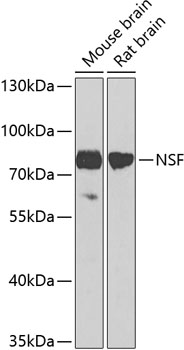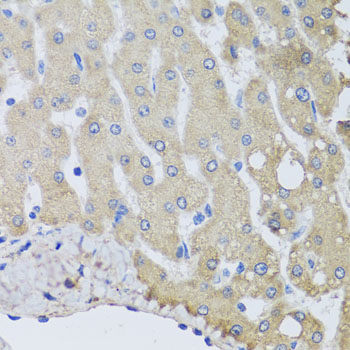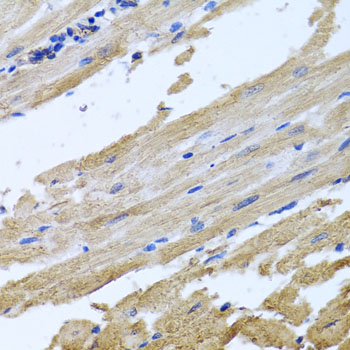-
Product Name
NSF Polyclonal Antibody
- Documents
-
Description
Polyclonal antibody to NSF
-
Tested applications
WB, IHC, IF
-
Species reactivity
Human, Mouse, Rat
-
Alternative names
NSF antibody; SEC18 antibody; SKD2 antibody; vesicle-fusing ATPase antibody
-
Isotype
Rabbit IgG
-
Preparation
Antigen: Recombinant fusion protein containing a sequence corresponding to amino acids 1-250 of human NSF (NP_006169.2).
-
Clonality
Polyclonal
-
Formulation
PBS with 0.02% sodium azide, 50% glycerol, pH7.3.
-
Storage instructions
Store at -20℃. Avoid freeze / thaw cycles.
-
Applications
WB 1:500 - 1:2000
IHC 1:50 - 1:100
IF 1:50 - 1:200 -
Validations

Western blot - NSF Polyclonal Antibody
Western blot analysis of extracts of various cell lines, using NSF antibody at 1:1000 dilution.Secondary antibody: HRP Goat Anti-Rabbit IgG (H+L) at 1:10000 dilution.Lysates/proteins: 25ug per lane.Blocking buffer: 3% nonfat dry milk in TBST.Detection: ECL Basic Kit .Exposure time: 15s.

Immunohistochemistry - NSF Polyclonal Antibody
Immunohistochemistry of paraffin-embedded human liver injury using NSF antibody at dilution of 1:100 (40x lens).

Immunohistochemistry - NSF Polyclonal Antibody
Immunohistochemistry of paraffin-embedded rat heart using NSF antibody at dilution of 1:100 (40x lens).
-
Background
Required for vesicle-mediated transport. Catalyzes the fusion of transport vesicles within the Golgi cisternae. Is also required for transport from the endoplasmic reticulum to the Golgi stack. Seems to function as a fusion protein required for the delivery of cargo proteins to all compartments of the Golgi stack independent of vesicle origin. Interaction with AMPAR subunit GRIA2 leads to influence GRIA2 membrane cycling (By similarity).
Related Products / Services
Please note: All products are "FOR RESEARCH USE ONLY AND ARE NOT INTENDED FOR DIAGNOSTIC OR THERAPEUTIC USE"
